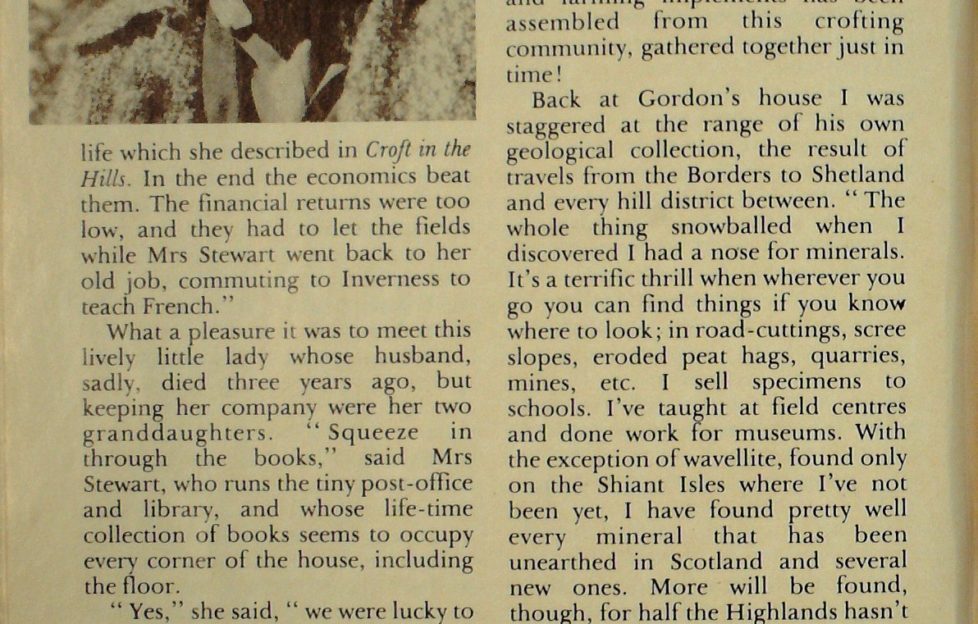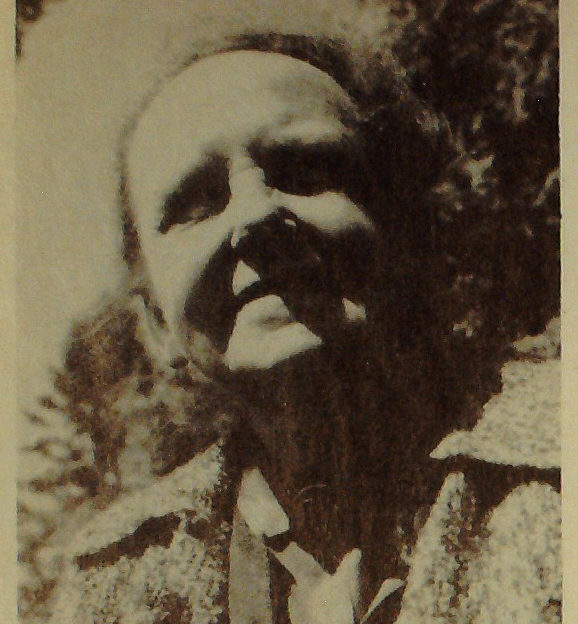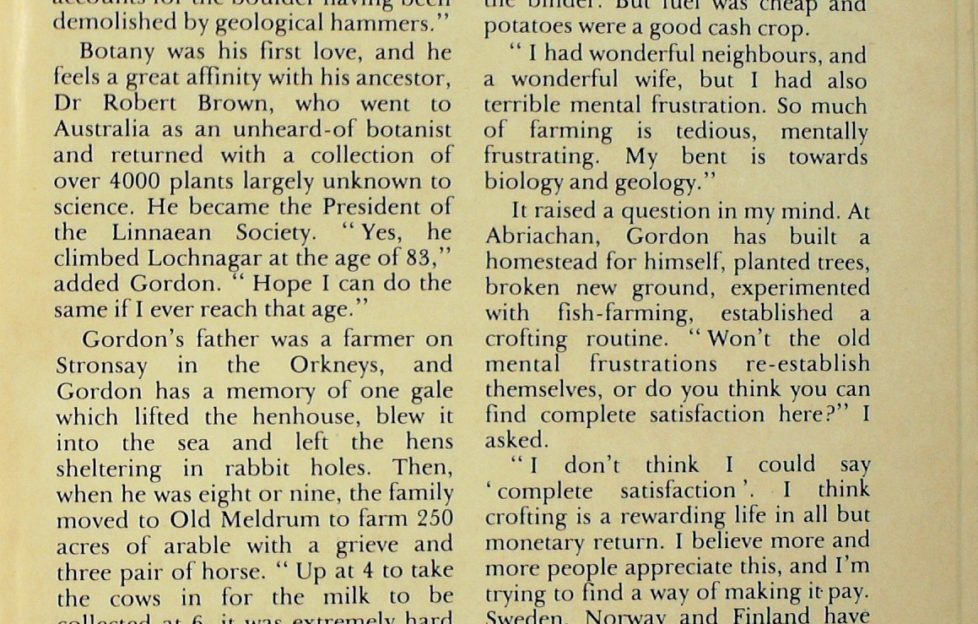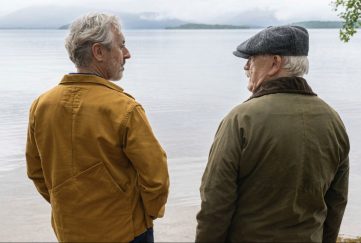Tom Weir | Sutherland’s Law (III)
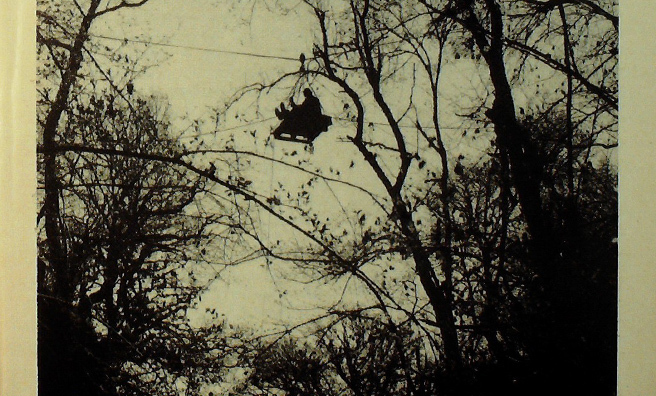
Part three of Tom Weir’s column on the crofting life and those who have returned to it
I’d like you to meet Mrs Katharine Stewart who wrote a book about crofting in Abriachan 20 years ago and it’s just been issued again.
She and her husband had the dream of being crofters and gave up everything to buy a high place on the moor above the loch and for ten years they had a marvellously happy life which she described in A Croft in the Hills.
In the end the economics beat them.
The financial returns were too low, and they had to let the fields while Mrs Stewart went back to her old job, commuting to Inverness to teach French.
“Squeeze in through the books”
What a pleasure it was to meet this lively little lady whose husband, sadly, died three years ago, but keeping her company were her two granddaughters.
“Squeeze in through the books,” said Mrs Stewart, who runs the tiny post-office and library, and whose life-time collection of books seems to occupy every corner of the house, including the floor.
“Yes,” she said, “we were lucky to come into crofting when we did, when so many of the old crofters were still working in the fields. We saw the end of an era, when survival depended on ripened crops and fattened beasts.
“Now so much of the farming land is neglected or ploughed for forestry. My book is a tale of other times when this was a crofting community.”
Sad thoughts, but she is not a sad woman, for she keeps her mind busy, writing dramatised history scripts for the BBC Education Service, and readers of The Scots Magazine will have read her poetry (November 1979).
Before we left we had a look at the nearby Folk Museum dealing with the crofting life of Abriachan which was a joint effort on the part of Katharine Stewart and the pupils of Inverness High School.
What a fascinating collection of household and farming implements has been assembled from this crofting community, gathered together just in time!
A Nose For Minerals
Back at Gordon’s house I was staggered at the range of his own geological collection, the result of travels from the Borders to Shetland and every hill district between.
“The whole thing snowballed when I discovered I had a nose for minerals. It’s a terrific thrill when wherever you go you can find things if you know where to look; in road-cuttings, scree slopes, eroded peat hags, quarries, mines, etc.
“I sell specimens to schools. I’ve taught at field centres and done work for museums.
“With the exception of wavellite, found only on the Shiant Isles where I’ve not been yet, I have found pretty well every mineral that has been unearthed in Scotland and several new ones. More will be found, though, for half the Highlands hasn’t been fully surveyed geologically.”
It was the desire to find a Cairngorm stone which set him off, and the sheer beauty and variety of different forms of crystal he found were a revelation.
He reckons his greatest bit of luck was finding the Heddle Boulder on Ben Bhreac near Tongue.
This had been a mystery for a hundred years and was thought to be a legendary thing no longer in existence.
“One summer evening I thought I’d have a look for it. Five minutes from the road I saw a rabbit dash into a hole and went over. There was a little piece of rock showing and I recognised it as Amazonite. I scraped away the turf and heather and there was the Boulder containing more minerals than any other ever found in Scotland.
“The Amazonite was a clue because it doesn’t occur anywhere else in Britain. I made the mistake of telling various people about it, including museums, which accounts for the boulder having been demolished by geological hammers.”
Botany In The Blood
Botany was his first love, and he feels a great affinity with his ancestor, Dr Robert Brown, who went to Australia as an unheard-of botanist and returned with a collection of over 4000 plants largely unknown to science.
He became the President of the Linnaean Society.
“Yes, he climbed Lochnagar at the age of 83,” added Gordon. “Hope I can do the same if I ever reach that age.”
Gordon’s father was a farmer on Stronsay in the Orkneys, and Gordon has a memory of one gale which lifted the henhouse, blew it into the sea and left the hens sheltering in rabbit holes.
Then, when he was eight or nine, the family moved to Old Meldrum to farm 250 acres of arable with a grieve and three pair of horse.
“Up at 4 to take the cows in for the milk to be collected at 6, it was extremely hard work,” he recalls.
In 1938 he joined the Forestry Commission with the intention of taking a degree, but 1939 saw him in the Gordon Highlanders, training for war, and he recalled his first sight of Norway, a cliff towering blackly above the sea in the moonlight on a pre-dawn raid on a whaling factory with a task force whose job it was to blow it up and give cover to Norwegians they were taking off.
It was in hospital in Blairgowrie in 1948, being treated for a knee, cut open while timber felling with an axe, that he met his future wife and went back to his beginnings to becoming a farmer.
He was first at Tom Breac on the slopes of Ben Lawers working with sheep mostly, then moved to Boreland to 60 acres of arable and 70 acres of hill at Kirkmichael.
A Harsh But Rewarding Life
“It was quite a struggle, ploughing by horse, using a water-mill for threshing. Lots of hard work haymaking, cutting corn with the binder. But fuel was cheap and potatoes were a good cash crop.
“I had wonderful neighbours, and a wonderful wife, but I had also terrible mental frustration. So much of farming is tedious, mentally frustrating. My bent is towards biology and geology.”
It raised a question in my mind. At Abriachan, Gordon has built a homestead for himself, planted trees, broken new ground, experimented with fish-farming, established a crofting routine.
“Won’t the old mental frustrations re-establish themselves, or do you think you can find complete satisfaction here?” I asked.
” I don’t think I could say ‘complete satisfaction”. I think crofting is a rewarding life in all but monetary return. I believe more and more people appreciate this, and I’m trying to find a way of making it-pay. Sweden, Norway and Finland have done more to keep their small farmers going than we have. I think there is a future in crofting allied to such things as contract work thinning timber for the Forestry Commission, or fish-farming, Norwegian-style. At the moment it’s tourism which helps, but it is seasonal. There has to be a way of earning enough cash to supplement the income from the croft.”
Katherine Stewart’s book, A Croft In The Hills is still in print and available here.
Read more from Tom next Friday.
More!
Read more from Tom!
We have an extensive archive of Tom Weir’s great columns for The Scots Magazine, and we’re slowly but surely getting them published digitally for new generations to enjoy.
To see the columns we have online so far, click here.


